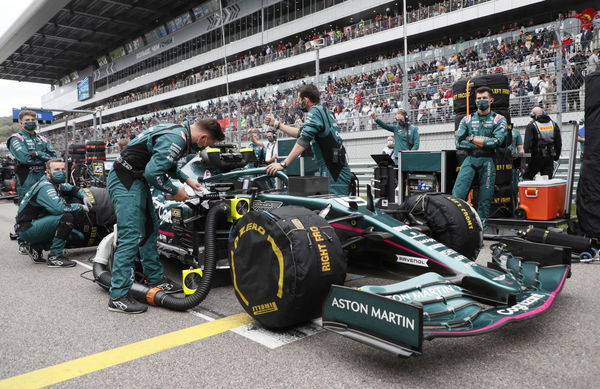
via Reuters
Formula One F1 – Russian Grand Prix – Sochi Autodrom, Sochi, Russia – September 26, 2021 Aston Martin’s Lance Stroll on the starting grid before the race Pool via REUTERS/Yuri Kochetkov

via Reuters
Formula One F1 – Russian Grand Prix – Sochi Autodrom, Sochi, Russia – September 26, 2021 Aston Martin’s Lance Stroll on the starting grid before the race Pool via REUTERS/Yuri Kochetkov
As much as Formula 1 is about speed, it’s also about strategy. When will a team bring their drivers in for a pit stop? Will they opt for an undercut or an overcut? Where will they come out? If you think about it, all these aspects of strategy have one underlying thing in common. An indispensable aspect of race strategy. It’s the choice of tire compounds. Every single race weekend, we hear a lot of discussion about tire compounds. Would it surprise you that a compound categorized as ‘hards’ over one weekend can be classified as ‘softs’ over the next?
Isn’t it bizarre? There are, in fact, a lot of regulations around the compound choices and tire allocations for each team, and sometimes, it may feel complicated. Don’t worry, though! We’re going to take you through the ‘whats’ and the ‘whys’ and all the different factors that weigh into making these decisions. What are C3 tires? Which tires are hards, mediums, and softs? More importantly, why are there different tire compounds for each circuit?
ADVERTISEMENT
Article continues below this ad
Tire compounds have a lot to do with the circuits F1 visits
While watching F1, you’ll notice that tires have different colored stripes around them. A red stripe is the ‘soft’ tire for that weekend; yellow is the ‘medium,’ and white is the ‘hard.’ These three compounds over a weekend are chosen from six compounds Pirelli—F1’s tire manufacturer—offers. They’re the C0, C1, C2, C3, C4, and C5—C0 is the hardest and C5 is the softest compound. Typically, the softer tires can generate more grip (and thus more speed) but also degrade the quickest. On the other hand, hard tires take longer to get up to temperature and generate grip but degrade the slowest. Considering six slick compounds, you can imagine that different compounds are chosen based on the venue. But why?

via Reuters
Formula One F1 – Italian Grand Prix – Autodromo Nazionale Monza, Monza, Italy – September 11, 2022 Red Bull’s Max Verstappen during a pit stop REUTERS/Ciro De Luca/Pool
F1 journalist Craig Scarborough explained why this is done in a YouTube video on F1’s channel. They said, “Each of the tracks is very different. If you think about from Monaco to Monza… circuits that either are all about straight line or acceleration or about how much cornering energy they have.” The track layout is one factor. Circuits like Monza and Austria have predominantly straights. Circuits like Monaco and Singapore focus more on cornering and turns, where the tire would take more abuse than on other tracks with minimal turns.
“Then, you’ve got other factors like the track surface. Barcelona [is a] very abrasive circuit.” The next is the degradation a particular track may offer. “Then you have different weather conditions, from cold, as we saw in Las Vegas, to absolutely baking in Qatar,“ explained Scarborough. Remember how Max Verstappen and Sergio Perez’s RB19 struggled in the cold temperatures at the Canadian GP? The continual change in tire compounds also adds a layer of intrigue over a weekend, considering how cars’ performance varies from tire to tire. While one compound may work for them, another might not. “All of these factors go together with how the car has to perform around the circuit,” concluded Scarborough.
Read More: Sainz and Leclerc to Test New Pirelli Tires in Old Ferrari F1 Car
How does F1 regulate all these tires, though? How can Pirelli be sure that a particular range of compounds would be perfect for a race weekend? That’s where Pirelli’s homework comes into play.
ADVERTISEMENT
Article continues below this ad
Pirelli’s tire allocation
Whether it be soft, medium, or hard tires, every set goes through a heat cycle at the optimum point of which they’re the fastest. But as soon as that peak period starts dying, they degrade to a point where the grip they offer falls off a cliff. How long that optimum period lasts also depends on the circuit. This means that the tire range chosen should suit a track. Per Scarborough, “They find that the softer tires, perhaps, won’t work on more aggressive circuits, and equally, harder tires won’t work on some of the more easygoing circuits.”

USA Today via Reuters
Nov 18, 2023; Las Vegas, Nevada, USA; Scuderia Ferrari driver Charles LeClerc of Monaco (16) during the Las Vegas Grand Prix at Las Vegas Strip Circuit. Mandatory Credit: Gary A. Vasquez-USA TODAY Sports
He added, “Pirelli will do all of their homework to try and guess the best range of tires to suit that track and to give some options on strategy for the race.” For instance, for the Las Vegas GP weekend, Pirelli chose the softest of the three compounds: C3, C4, and C5. Each driver is given 13 sets of tires for the race weekend.
ADVERTISEMENT
Article continues below this ad
Watch this Story: Mario Andretti Teases Blockbuster American Formula 1 Team in 2024
Has this made things clear? What are your thoughts on F1 using different tire compounds based on the circuits?
ADVERTISEMENT
ADVERTISEMENT
ADVERTISEMENT
ADVERTISEMENT

